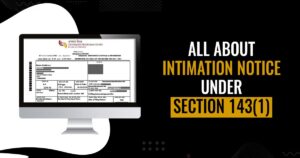 After income tax (I-T) return is filed, the tax department sends an intimation under section 143(1) that can include a tax demand
After income tax (I-T) return is filed, the tax department sends an intimation under section 143(1) that can include a tax demand
After an income tax return (I-T return) has been filed, the tax department sends an intimation under section 143(1) to highlight any discrepancy that might arise from a lower tax paid than what was meant to be paid.
In case of a lower tax paid, the tax payer is meant to pay the balance amount and resolve the issue. And in case of excess amount, the tax refund is disbursed by the department to the assessee’s bank account that is linked for this very purpose.
Individuals are supposed to file their income tax returns on or before July 31 of the assessment year. After the return has been filed, the tax department carries out processing of the return.
During this process, the tax department might come across a number of discrepancies such as that of data, calculations, among others. In such cases, the department will send a notice — also referred to as intimation under section 143(1).
This notice is sent on the tax payer’s registered email ID. An SMS is also sent on the registered mobile number informing that the intimation notice has been sent to the registered email ID.
Once the intimation is received from the department, there could be a number of scenarios that follow, e.g., wrong deduction of TDS from salary and under-reporting of income.
Chirag Chauhan, Founder of CA Chauhan & Co, says there could be three likely scenarios. The first one is that the tax department does not raise any demand for income tax. In this case, assessee does not have to worry over anything. The second scenario could be that of a tax refund. And the third is that there is a tax demand.
“It is important for the tax payer to first identify the scenario, and accordingly rectify the computation. For instance, if TDS is not considered by the department, then one can apply for it to be considered — thereby reducing the tax liability. There are, therefore, multiple permutations and combinations and the response will vary from case to case,” says Mr Chauhan.
There could be a situation that these changes are not reflected in the tax return by December 31. In such a case, one can always rectify the return afterwards. “The deadline for filing a revised return gets over on Dec 31, but one can always rectify his/her return later. There is also an option of raising a grievance or approaching the CPC,” says Mr Chauhan.
Although the department usually sends a notice within a short period of filing of tax return, the maximum time limit of sending this intimation is nine months from the end of financial year in which the return has been filed.
Source: https://mintgenie.livemint.com/news/personal-finance/income-tax-return-filing-did-you-get-an-intimation-notice-under-section-143-1-here-s-what-it-means-151672729129419
© 2018 CA Chandan Agarwal. All rights reserved.